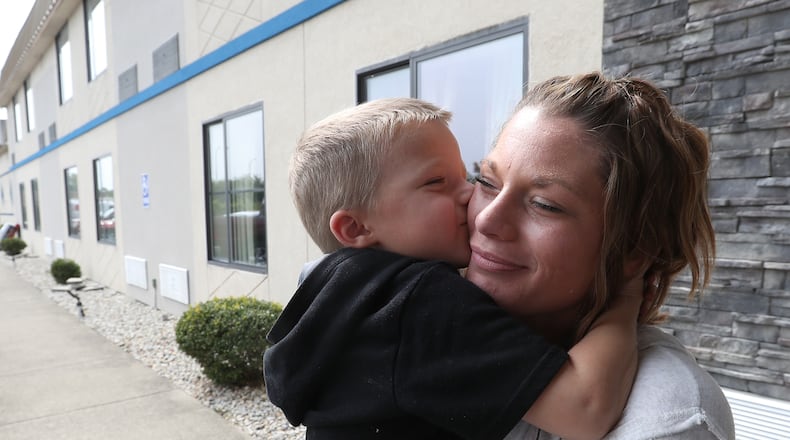As of Wednesday, there were 140 people classified as homeless in emergency shelter in the county. An additional 91 single adults and 49 families have been placed on a waiting list, according to the Interfaith Hospitality Network, which provides services to the homeless.
That nonprofit’s Executive Director Elaina Bradley said there has not been a waiting list for those to be placed in emergency shelter in the county for over 10 years. It comes at a time when the average number of people needing emergency shelter in the county has nearly doubled.
“It has been very disheartening. We have seen an influx in the need for those individuals and families that are homeless,” Bradley said.
Interfaith operates two congregant living shelters in the county. One serves single men while the other serves women and children. The nonprofit also provides other services designed to help the homeless population find stable employment and permanent housing.
However, those congregant living spaces have been closed since March due to safety concerns related to the coronavirus pandemic.
“We have had to use alternative forms of shelter. We have been housing people at various off sight locations. We have utilized motel and hotel rooms throughout the community,” Bradley said.
Prior to the pandemic, the normal capacity between the two shelters, was an average of 70 people. However, the impact of the pandemic started to be felt in the county in March. In the following months there was a gradual increase in the number of those that needed temporary shelter. However, that number saw a spike towards the end of the summer.
Bradley said they saw a large influx in the need for those services starting in August, with that number surpassing more than 100 people. That increase prompted the use of a waiting list.
Julie Johns, a mother of two, said she was on that waiting list for about a week before temporary shelter was secured for her. She is now staying at a motel with her two young sons.
Her previous living situation became unstable. Johns said that she was previously in what she described as “a toxic relationship that was getting worse.” She added that she was previously an addict and wanted to get sober and stay clean for her children.
“It has been a really long road with that,” she said.
Johns was connected with Interfaith after going to McKinley Hall, which provides drug and alcohol treatment services. At the time, her housing situation was not that dire, as she latter explained. However, it soon took a turn for the worst.
“It was not as serious when I first got on it. I knew that I needed somewhere to go, that I was going to be homeless,” Johns said when she was placed on the waiting list.
She said that a children services worker and McKinley Hall helped Interfaith understand how bad she needed those services.
“The last three days before I got in (emergency shelter) were the worst though. I was literally on the street with my boys, just walking,” she said.
Johns said an elderly relative did let them stay a night. However, Johns said she did not want to put extra stress on that relative.
“I am very lucky that I got in the way that I did. My wait was not as long as others. But I worked very hard at letting them know my situation. I kept calling," she said.
“If you tell people your situation and you’re honest, there is more people in this world willing to help than you realize,” she added.
The average stay of people in emergency shelter has also increased during the pandemic. That average is between 75 to 80 days, compared to an average stay of 28 to 39 days before the pandemic, Bradley said.
Bradley said they are currently in the preliminary stages of potentially renovating an existing location in the community and turning it into a shelter.
The idea is to have a space that could hold up to 50 individuals, including a mix of families and single men and women. They would be housed in separate quarters to ensure social distancing and safety.
Local officials say there are multiple factors contributing to the increased need for services.
The coronavirus pandemic has had an immediate economic impact. A statewide stay-at-home order enacted in March called for the temporary closing of businesses that were deemed nonessential. Ohio began reopening portions of its economy starting in May and businesses that were once deemed non-essential were allowed to reopen.
Companies that have remained open during the entire period have also had to tweak their operations.
But there are individuals and families that are still dealing with the economic impact of the pandemic, Meadows said.
Some residents have lost their jobs, while others had their hours cut. There were also delays in getting unemployment benefits as the state saw a record amount of people applying between March and April.
The unemployment rate in Clark County went from 5.3% to 17.4% between those months, according to the Ohio Department of Job and Family Services.
At that time, the state had added enhancements to unemployment benefits due to so many people being permanently or temporarily laid off from their jobs.
Meadows said all those factors can strain an individual or family’s financial stability as well as their ability to pay bills or rent.
Amid the pandemic, several energy providers suspended disconnections.
The city of Springfield also announced in June that it would suspend disconnections on past due water and sewer utility accounts for a month. That was later extended until Sept. 7.
Kerri Brammer, with the Neighborhood Housing Partnership of Greater Springfield, said that those gas and electric shutoffs can resume soon.
Meadows said that local energy providers such as Ohio Edison and Columbia Gas are working with customers in an attempt to make sure that does not happen.
Enhanced unemployment benefits as well as the moratorium on evictions associated with the CARES Act, a relief package passed by congress in March, have since expired. The latter, which occurred in July, has allowed the eviction process to resume in court.
Numbers released by the Clark County Municipal Court shows a decrease in forcible detainer and entry filings related to evictions this year. As of August, 574 of those filings have been logged for the year compared to the 794 during the same time period in 2019.
According to data shared by Meadows, 89 of those were made in August. She said similar filings made in the previous months were delayed due to the federal moratorium on evictions.
However, the Centers for Disease Control and Prevention this month issued an unprecedented nationwide order banning landlords from evicting tenants who meet certain criteria.
The CDC’s order requires that tenants fill out and send in a declaration form to their landlords, under penalty of perjury, that says they qualify for eviction protection, this news organization previously reported.
The order blocks landlords from evicting tenants between Sept. 4 to Dec. 31. But it only applies to those who submit these declaration forms, unless the order is changed or extended.
Meadows said that the previous moratorium on evictions did delay the court process but did not absolve what renters will eventually owe to their landlords. She said the same applies to the recent CDC order.
These issues have prompted the Neighborhood Housing Partnership of Greater Springfield to work with the city to create a program to address those needs.
The goal is provide more rental and utility assistance for those facing financial hardships due to the coronavirus pandemic. As a result, the Housing Financial Assistance Program was created and started accepting referrals in August.
As of Wednesday, 105 people have applied for assistance, Brammer said.
As of August, the city has been awarded over $2 million in HUD grants using money set aside by the CARES Act. The city is under contract with the NHP to provide the latter $75,000 in those federal relief funds.
In addition, some of that CARES Act money has been earmarked for rent and assistance through the Interfaith.
The city is also using $125,000 in non-coronavirus related funding that has been awarded through HUD’s Home Partnership Program for additional rent and utility assistance.
The program with the Neighborhood Housing Partnership aims to offer three months of rental and utility assistance, up to a maximum of $1,500 per month. The furthest back that the program will go regarding past due payments is April 1.
In order to be eligible, residents must prove that they have been financially impacted by the coronavirus pandemic. They cannot be currently receiving a tenant-based voucher, project-based voucher, in public housing or receiving other government-based rental assistance.
Brammer said that a program focusing on renters is a new concept for her organization as they have traditionally focused on home ownership.
However, only residents of Springfield can apply. Those that have requested help have not faced eviction at this point, Brammer said.
By the numbers:
140: People in emergency shelters in Clark County as of Wednesday evening
91: Number of single adults on a waiting list for those services
49: Families on waiting list for those services
About the Author

